MSI B85M ECO Review: Aiming Green at $73
by Ian Cutress on November 26, 2014 8:00 AM EST- Posted in
- Motherboards
- MSI
- B85
- ECO
CPU Benchmarks
Readers of our motherboard review section will have noted the trend in modern motherboards to implement a form of MultiCore Enhancement / Acceleration / Turbo (read our report here) on their motherboards. This does several things, including better benchmark results at stock settings (not entirely needed if overclocking is an end-user goal) at the expense of heat and temperature. It also gives in essence an automatic overclock which may be against what the user wants. Our testing methodology is ‘out-of-the-box’, with the latest public BIOS installed and XMP enabled, and thus subject to the whims of this feature. It is ultimately up to the motherboard manufacturer to take this risk – and manufacturers taking risks in the setup is something they do on every product (think C-state settings, USB priority, DPC Latency / monitoring priority, memory subtimings at JEDEC). Processor speed change is part of that risk, and ultimately if no overclocking is planned, some motherboards will affect how fast that shiny new processor goes and can be an important factor in the system build.
For reference, the B85M ECO does not have any form of MultiCore Turbo.
Point Calculations – 3D Movement Algorithm Test: link
3DPM is a self-penned benchmark, taking basic 3D movement algorithms used in Brownian Motion simulations and testing them for speed. High floating point performance, MHz and IPC wins in the single thread version, whereas the multithread version has to handle the threads and loves more cores.
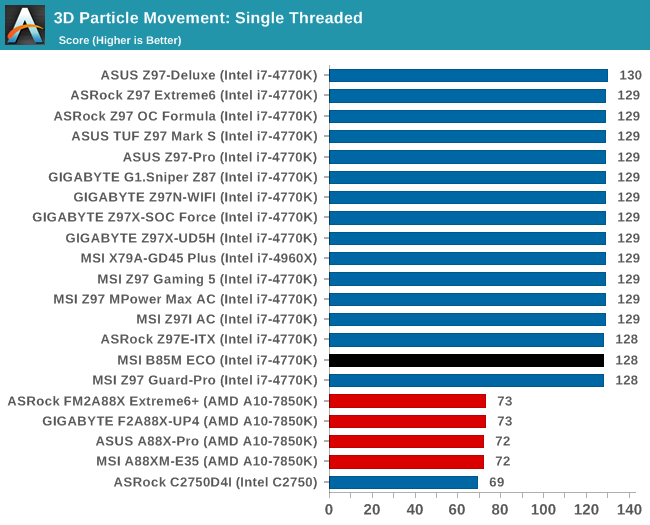
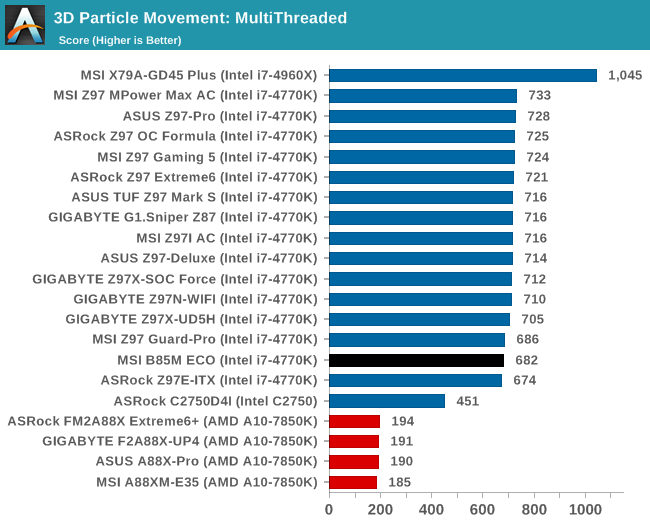
Compression – WinRAR 5.0.1: link
Our WinRAR test from 2013 is updated to the latest version of WinRAR at the start of 2014. We compress a set of 2867 files across 320 folders totaling 1.52 GB in size – 95% of these files are small typical website files, and the rest (90% of the size) are small 30 second 720p videos.
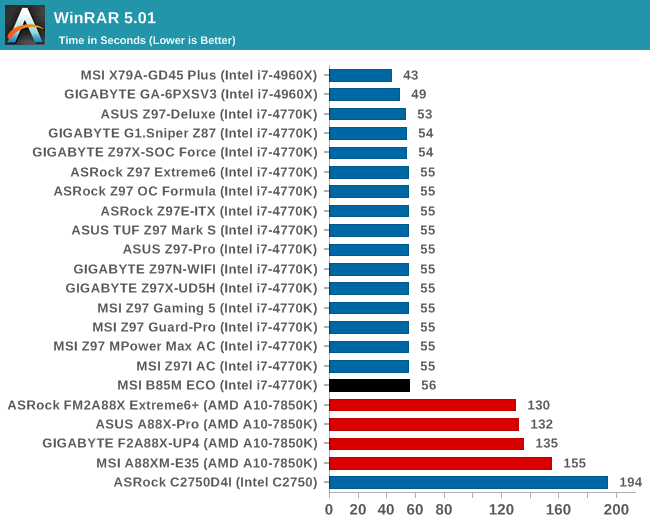
Image Manipulation – FastStone Image Viewer 4.9: link
Similarly to WinRAR, the FastStone test us updated for 2014 to the latest version. FastStone is the program I use to perform quick or bulk actions on images, such as resizing, adjusting for color and cropping. In our test we take a series of 170 images in various sizes and formats and convert them all into 640x480 .gif files, maintaining the aspect ratio. FastStone does not use multithreading for this test, and thus single threaded performance is often the winner.
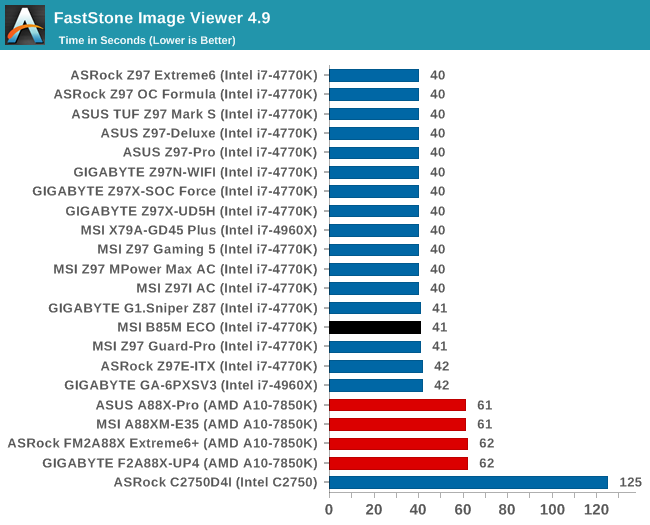
Video Conversion – Handbrake v0.9.9: link
Handbrake is a media conversion tool that was initially designed to help DVD ISOs and Video CDs into more common video formats. The principle today is still the same, primarily as an output for H.264 + AAC/MP3 audio within an MKV container. In our test we use the same videos as in the Xilisoft test, and results are given in frames per second.
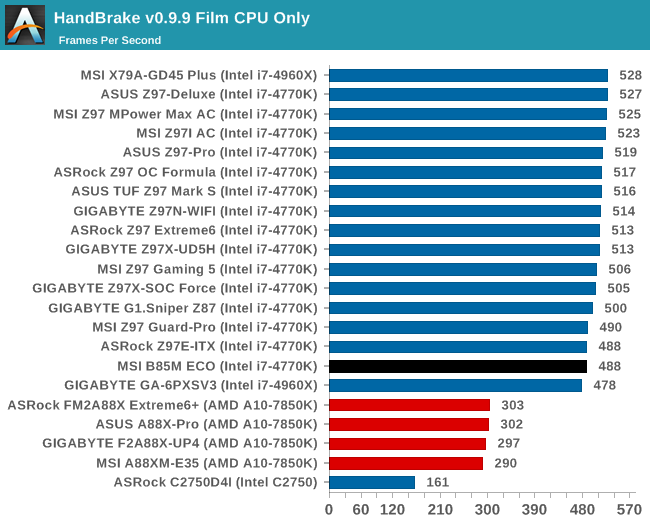
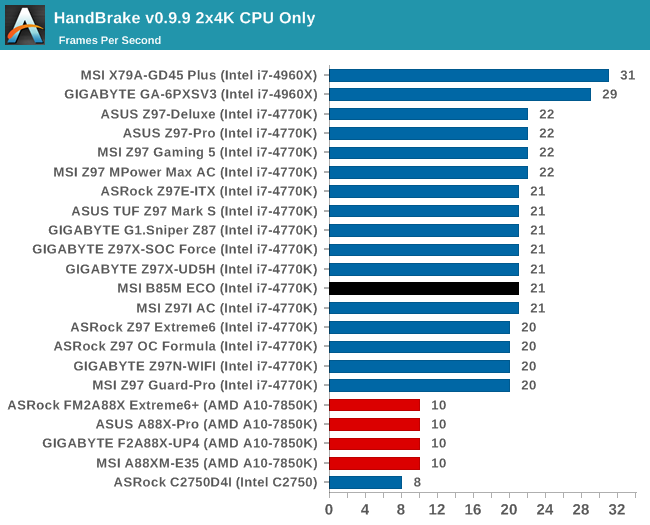
Rendering – PovRay 3.7: link
The Persistence of Vision RayTracer, or PovRay, is a freeware package for as the name suggests, ray tracing. It is a pure renderer, rather than modeling software, but the latest beta version contains a handy benchmark for stressing all processing threads on a platform. We have been using this test in motherboard reviews to test memory stability at various CPU speeds to good effect – if it passes the test, the IMC in the CPU is stable for a given CPU speed. As a CPU test, it runs for approximately 2-3 minutes on high end platforms.
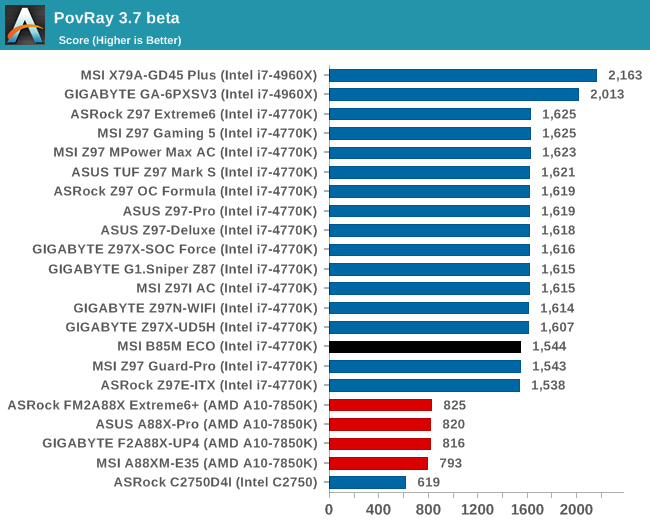
Synthetic – 7-Zip 9.2: link
As an open source compression tool, 7-Zip is a popular tool for making sets of files easier to handle and transfer. The software offers up its own benchmark, to which we report the result.
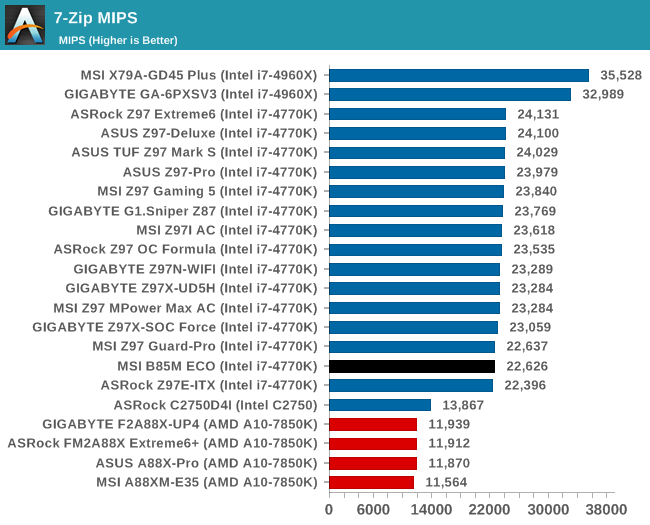










40 Comments
View All Comments
Jaaap - Wednesday, November 26, 2014 - link
For these ECO boards it would be very interesting to get and idle power for a setup without external videocard.Jaaap - Wednesday, November 26, 2014 - link
Arg i should read better: 21W minimumklagermkii - Wednesday, November 26, 2014 - link
Thanks for showing separate idle and load power usage in the review and not just delta.bill.rookard - Wednesday, November 26, 2014 - link
The area I think where this would do fairly well would be as a SMB server. I know I tend to keep things for far longer than 5 years which would be the break even point on the cost - once they have something that works, and works well (and works correctly) they'll leave it in place until it dies, and for something as simple as file serving, you just want something durable and reliable.mike_m_ekim - Friday, December 12, 2014 - link
Another great use is a HTPC. My HTPC uses a 35-watt haswell CPU. Passive cooling isn't an option because of location, so fans are required. Another 10 watt reduction in system heat would allow the fans to run just a little slower, making my nearly silent PC even quieter.mike_m_ekim - Friday, December 12, 2014 - link
One other thing, my HTPC is on 24/7 and transcoding almost all the time. I would see a $25 savings in electricity over 3 years, and an HTPC should be able to last much longer (because it's just an appliance). The cost savings would be secondary (noise being the biggest factor).MrSpadge - Wednesday, November 26, 2014 - link
My PC is number-crunching 24/7, so saving 12 W would save me about 6€/year (yeah, no fracking in Germany). A Z97 ECO could be interesting, because even with massive undervolting to ~1.0 V, current Intel CPUs are still asking to be OC'ed to ~4.0 GHz. I couldn't do that with a B chipset.DanNeely - Wednesday, November 26, 2014 - link
Is your math right? Your cost saving number seems low. For 24/7/365 operation a 1W load corresponds to 8.76 kwh/year; at an electricity price of 11.5 cents per kwh (reasonably close for most of the US) it works out as a dollar per wattyear or $12/year savings. My understanding is that German electric prices are several times higher, and am wondering if you lost a zero in your calculations.Jaaap - Wednesday, November 26, 2014 - link
You're right. One WattYear is approx 2 euro.MrSpadge - Wednesday, November 26, 2014 - link
8.76 kWh for 11.5 US-ct -> 1 W = 1 $/year in the US8.76 kWh for 23 EUR-ct -> 1 W = 2 €/year in Germany
... the cost is higher over here, but not an order of magnitude :)